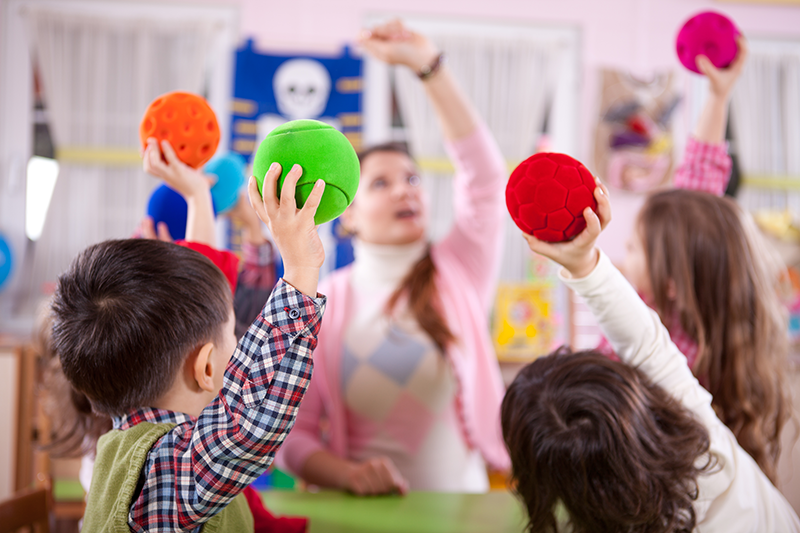How Do Educators Influence Physical Activity in Early Years Settings?

Understanding the impact that early years educator behaviours have on young children’s physical activity is crucial as they play a key role in shaping children’s development. In particular, the early years are when habits and foundational skills are developed and therefore a vital time for engagement in active play and physical activity. With children’s physical activity levels alarmingly low, we undertook a systematic review aimed at examining how specific educator actions influence children’s activity levels in early years settings.
The importance of physical activity in early years
It is widely acknowledged that physical activity is crucial for the overall development of young children. Physical activity through active play contributes not only to physical health such as strong bones and efficient muscles, but also to improving problem-solving and decision making skills, building relationships with others and learning to understand and manage emotions. Despite these benefits, many children, both in Canada and globally, are not meeting the recommended levels of physical activity. Only 24% of Canadian children aged 3 to 4 years old meet the guideline of 60 minutes of moderate to vigorous physical activity each day. Moderate to vigorous physical activity means doing things that make your heart beat faster and make you breathe harder. Moderate activity includes things like fast walking or fun dancing, where you can still talk but are moving a lot. Vigorous activity is more intense, like running, jumping, or playing tag, where it’s harder to talk because you’re breathing so fast. These activities are important for helping kids grow strong and stay healthy, both in their bodies and their minds.
Educators as key influencers
Our research aimed to understand what the current literature states about how educators impact children’s physical activity levels. The review examined 11 studies from various countries, each exploring different aspects of educator behaviours including active participation, role modelling, verbal encouragement and activity planning. For example, active participation might involve educators starting a catching challenge with juggling scarves and helping children practice their throwing and catching skills. Role modeling can occur when educators demonstrate healthy habits by starting the day with a stretching routine or participating in a dance activity during music time, showing children how enjoyable being active can be. Verbal encouragement can include motivating children to keep moving with specific praise and ideas like, “I love the way you are jumping from place to place! Can you think of different ways to move around?”. Lastly, thinking of activities to do before each day, like specific games or activity planning could involve setting up a range of physical activities, such as a dance session to different music styles or a relay race that includes jumping, balancing, and tossing bean bags, ensuring children practice multiple movement skills.
The findings were clear: educators play a pivotal role in encouraging physical activity through active play. In many cases, children were more active when the educators were also physically active, either participating in the same activities or serving as active role models. This highlights the importance of the educator’s own engagement in physical activities, not just as facilitators but as participants who model active behaviour. However, we understand that some educators may have injuries or other circumstances that keep them from being physically active with the children. These individuals can still play a key role in encouraging movement.
The power of verbal encouragement
Another key finding from our research was the importance of verbal encouragement. Several studies revealed that when educators prompt or encourage children to move, the children are more likely to engage in physical activity. This supports existing theories on motivation and self-determination, which suggest that positive reinforcement from authority figures can significantly boost an individual’s willingness to participate in physical activity.
Verbal prompts can be simple yet effective, such as encouraging children to join in a game, explore new equipment or engage in active play. Our research found that these seemingly small interactions can have an impact on a child’s physical activity levels, particularly in environments in a centre where children might otherwise remain sedentary such as a sand pit or mud kitchen.
Adult interaction needs to change
Our study also found an interesting interplay between adult interaction with children and a decrease in physical activity. Interactions between educators and children often led to sedentary behaviour as they were the facilitators of activities like reading, art, crafts and other table-based tasks that are naturally more sedentary. These activities play an important role in child development, but should not be the only activities facilitated by educators. Though outdoor environments provide more opportunities for movement, educator interactions were thought to reduce children’s activity levels because they were ‘stop’ communications, such as refraining from playing on certain equipment or engaging in play that they perceive to be too risky.
In addition to this, the review found that educators shift their role in different environments. In an indoor environment, educators are more likely to create or facilitate an activity for the children to participate in, such as reading stories, singing songs or creating art. Outside however, this role shifts to more a supervisory role, giving the children free reign to choose what they do and only interacting in the ways stated above.
Because of this, reframing adult interactions with children in the early years is important. Educators should be seen as those that can provide ideas for movement, ones that can start a game when they see children become more sedentary and create an environment for a dance party before snack. This can be done by incorporating and understanding the spectrum of play-based learning.
Understanding physical activity through a play-based learning spectrum
Using a play-based learning spectrum to engage children in physical activity through a multi-modal approach creates an environment for holistic development. This approach enables educators to understand that interactions occur on a spectrum from child-led free play through to educator-directed instruction, offering children opportunities to develop not just physical skills but also cognitive and social abilities through different forms of facilitation and interaction.
Educators may facilitate an activity to introduce and develop certain movement skills with games that incorporate elements of curiosity, imagination and adaptability. By doing this, children are engaged and willing to participate while maintaining important elements of playfulness. Then later in the day or week, any items that were used in the activity may be placed in the environment for children to choose to play with. If a child does play with it, then the educator can begin to role model some movements or provide encouragement and ideas of ways to use the items.
To foster physical literacy in early years settings, it is essential that educators adopt a more active role in both facilitating and participating in children’s play. Based on our findings, educators should be encouraged to engage directly in physical activities, either through active participation or role modelling, to create an environment that promotes movement. For those unable to participate fully due to personal limitations, utilising verbal encouragement and planning environmental stimulation remain powerful tools to motivate children to be active.
Reframing how educators interact with children is crucial. Instead of viewing interactions as moments of supervision or restraint, educators should look for opportunities to inspire and guide physical movement, both indoors and outdoors. This can include initiating games, offering movement ideas during play, or simply being aware of when children may need a prompt to engage more actively. Educators should also be encouraged to embrace the play-based learning spectrum, using it to balance structured and free play activities that allow children to explore movement in a playful, curious manner.
Professional development programs should focus on empowering educators to use physical activity as a natural part of their daily interactions, offering training on how to embed movement into routines, facilitate physically active games and promote an environment where children can safely explore different types of play. By doing so, educators can help combat the low levels of physical activity seen in early years and foster the holistic development of the children in their care.
Wright, C., Kirkhope, S., & Buckler, E. J. (2024). Systematic review of educator behaviours associated with physical activity of early years children. Child: Care, Health and Development, 50(4), e13308. https://doi.org/10.1111/cch.13308

